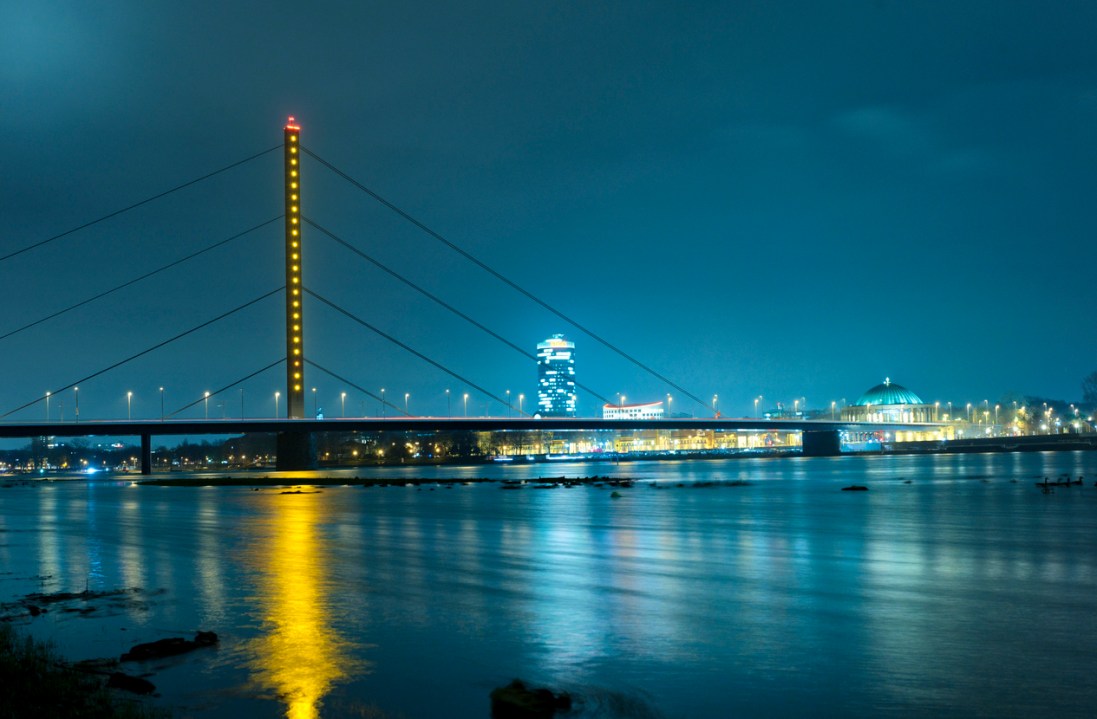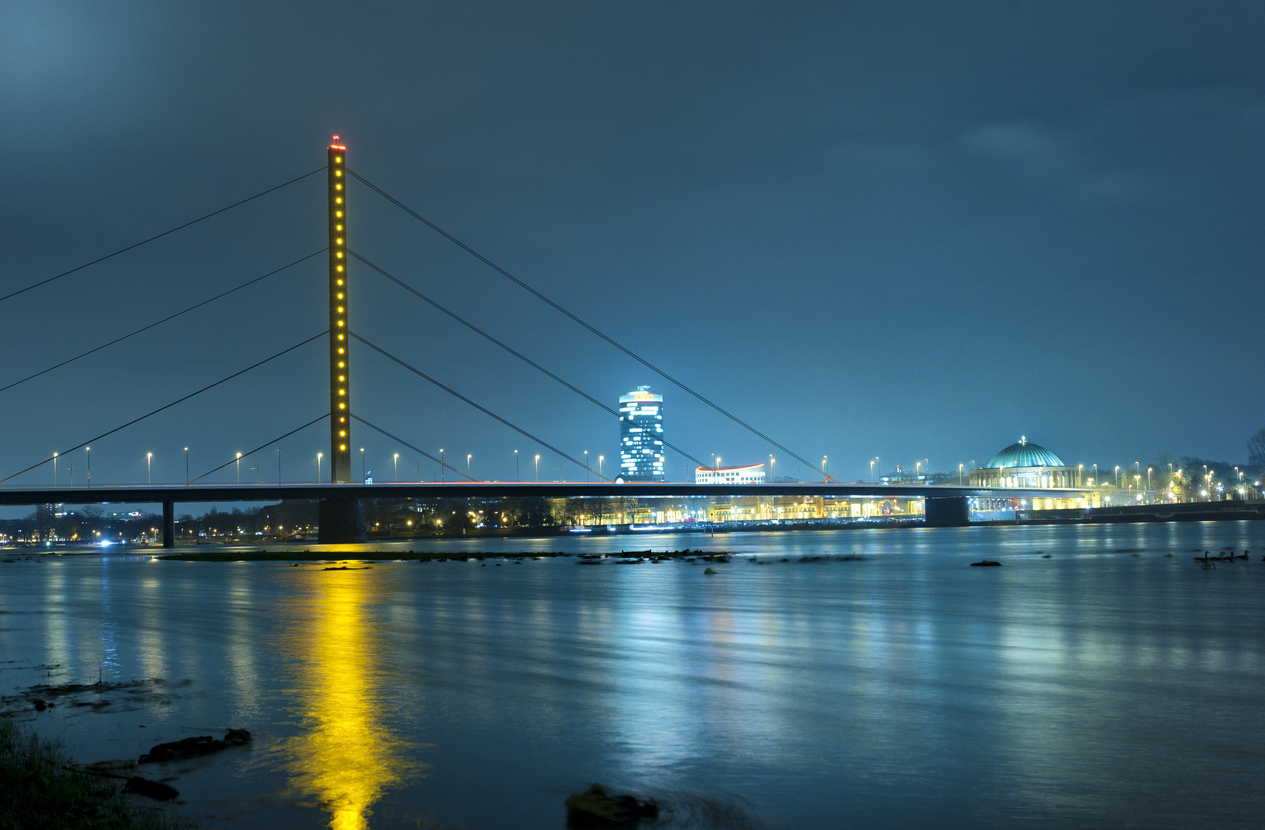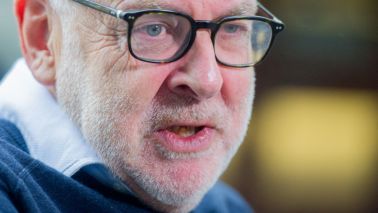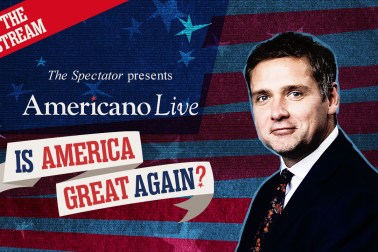In the cavernous basement of Bilker Bunker, a second world war air raid shelter in downtown Düsseldorf, the staff of groovy events guide the Dorf are toasting the magazine’s tenth birthday. During the war, Germans sheltered here from the RAF. Today, their descendants come here to party. With an art gallery up above and DJs down below, this labyrinthine concrete relic is a symbol of Düsseldorf’s transformation – from industrial powerhouse of the Third Reich to Germany’s hippest city.
Düsseldorf has always been a wealthy city, the buckle of the German rustbelt
The Dorf is the size of a slim paperback. It fits neatly into your coat pocket. It started out online but its success soon spawned a print edition: art, music, fashion and loads of entertainment listings. It’s like a throwback to the 1980s when inky newsprint still reigned supreme. I thought these old-school listings mags were all killed off by the internet. Seems I was mistaken. The people at this birthday bash are half my age (and twice as stylish as I ever was) and the latest edition of the Dorf is full of equally chic events, all over town.
I’ve been reporting from Germany for 30 years, off and on, crisscrossing this complex country more times than I can count but for a long while I steered clear of Düsseldorf. Like most German cities, it was bombed flat by the RAF and rebuilt in a dreadful hurry, in dreary modernist style. It had no iconic landmarks, no must-see sites. It lacked the dark allure of Berlin.
But as I travelled around the Bundesrepublik, the name of the place kept cropping up. Artsy Germans assured me it was a creative hotspot and so ten years ago I decided it was high time I paid a visit. I was amazed by what I found. Sure, much of the city looked pretty drab but it was a hive of artistry: several of Europe’s leading museums, plus countless commercial galleries. It seemed there were artists everywhere. It felt like a city on the rise.
I’ve been back half a dozen times since then and I like it more each time I come here. It’s not a place you’d go for sightseeing but it’s dynamic and authentic. With a population of 600,000, it’s about the same size as Glasgow – a city with which it has quite a lot in common. Like Glasgow, it owes its living to the water. The mighty Rhine, which runs through the heart of town, gives it a potent maritime air. An international inland port, a place of arrival and departure, its riverside is festooned with bars and nightclubs. After dark, the narrow streets along the waterfront are awash with tipsy revellers.
I was back in town last month for the swanky reopening of the Kunstpalast, the city’s leading art gallery. Closed for three years for renovation, the dramatic rehang is like a time tunnel through the history of western art. Most of the big names in European art are here, including some gutsy German expressionists, whom you rarely see in Britain but the most remarkable exhibit is an immaculate recreation of Cream Cheese, the Düsseldorf nightclub where a local band called Kraftwerk played their first gig. On the back wall is a mural by Gerhard Richter, now one of the world’s most famous (and expensive) artists. Richter studied just across the road at Düsseldorf’s Kunstakademie, then as now one of Europe’s leading art schools. Its list of alumni includes some of the most exciting artists of the last century: Joseph Beuys, Anselm Kiefer, Sigmar Polke, Andreas Gursky…
Kraftwerk’s influence has been even more far-reaching, pioneering electronic music, inspiring everyone from David Bowie to Daft Punk, from the Pet Shop Boys to Coldplay. A generation of British bands followed in their footsteps (Joy Division, Soft Cell, Depeche Mode…) and their futuristic sound crossed the Atlantic, galvanising nascent house and hip-hop bands in Chicago and Detroit. Now the wheel has come full circle: Düsseldorf now has a thriving hip-hop scene. Check the Dorf for details.
If hip-hop isn’t your thing (maybe you’re too old and square, like me) there are lots of other ways to let your hair down in Düsseldorf. The Altstadt (Old Town) is full of places where you can sample altbier, the local malty brew. Most of these bars serve decent grub – all the usual hearty Teutonic staples, the best way to line your stomach after all that beer. If you fancy something more refined, Düsseldorf has the biggest Japanese community in Germany (the third biggest in Europe, after London and Paris) and there are loads of Japanese restaurants clustered around the Hauptbahnhof (central station). I feasted on fresh sushi at Kushi-Tei of Tokyo on Immermannstrasse, washed down with a few glasses of Kirin Ichiban, a crisp Japanese lager. With 7,000 Japanese residents, no wonder locals call this area Nippon am Rhein.
Düsseldorf has always been a wealthy city, the buckle of the German rustbelt. Built on coal and steel but spared the brownfield blight of the Ruhrgebiet, it’s now become a hi-tech hub – a realisation of Kraftwerk’s prophecy in albums like Computer World. The Königsallee is the city’s smartest street, lined with designer stores (Claudia Schiffer was first spotted in a nightclub here – shades of Kraftwerk’s hit single, ‘The Model’) but unless you’ve got money to burn, Bilk is a more interesting district, full of quirky shops and cafes.
There are plenty of good places to stay. If I’m paying my own way, I like to stay at 25hours. It’s a modern high-rise hotel and from the outside it doesn’t look like much but the stylish interior is warm and welcoming. The communal areas are lively and sociable and the minimalist bedrooms are snug and cosy. I’d recommend the in-house restaurant, too. If I’m spending someone else’s money, I’ll stay at The Wellem. It calls itself a boutique hotel but in fact it’s quite the opposite – a palatial, neoclassical building, a bombastic remnant of Bismarck’s Second Reich. It’s in a great location, on the edge of the Altstadt and a short walk from the Kunstpalast.
Ironically, it was the Brits who put Düsseldorf back on the map after its destruction by the RAF. The city and its hinterland fell within the British area of occupation and since Cologne had been even more badly bombed, they established their HQ here and subsequently made Düsseldorf the capital of Nordrhein-Westfalen (North Rhine Westphalia), a new portmanteau state which became Germany’s richest and most populous region. The victorious allies imposed a federal model upon a defeated Germany and state capitals like Düsseldorf have prospered from their autonomy. It makes you wonder whether such a model might work rather well for Britain, too.
I finished my latest trip on the windswept promenade beside the Rhine, watching the huge barges chugging past – northwards to the Netherlands and southbound to Switzerland. Düsseldorf is not a pretty place but like Glasgow or Chicago, it has a restless energy which always brings me back. It’s ugly cities like these that produce great art and music. Will Bilker Bunker launch the next Kraftwerk, the next Gerhard Richter? Watch this space.







Comments